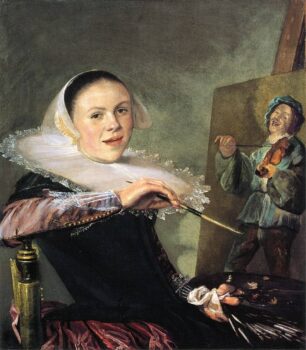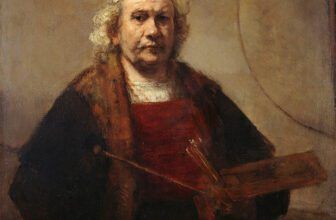Judith Leyster’s Famous Paintings
The Forgotten Star of the Dutch Golden Age
When people think of the Dutch Golden Age, the names that usually come to mind are Rembrandt, Frans Hals, and Johannes Vermeer. Their works grace the halls of the world’s greatest museums, and their legacies are endlessly studied and celebrated. But hidden in the shadows of these masters lies a woman whose brilliance was nearly forgotten for centuries: Judith Leyster (1609–1660).
Today, Leyster is regarded as one of the few prominent female painters of the 17th century, a woman who, against all odds, carved a space for herself in a world dominated by men. Her paintings, filled with music, laughter, and human connection, reveal a sensitivity and liveliness that continues to captivate viewers. But her story is not just one of artistic achievement; it is also a tale of obscurity, rediscovery, and a powerful legacy.
The Story of Judith Leyster
Judith Leyster was born in Haarlem, in 1609, the eighth child of a local brewer. Her surname, Leyster, which translates as “lodestar” or “leading star,” would later become both her artistic monogram and a metaphor for her short but shining career.
Little is known about her early training, but her talent must have been recognized quickly. Haarlem at the time was a bustling artistic hub, home to painters like Frans Hals and Jan Miense Molenaer. Leyster was likely influenced by Hals’s loose, lively brushwork and Molenaer’s genre scenes of everyday life.
By her early twenties, Judith Leyster had established herself as an independent artist, a rarity for a woman in 17th-century Holland. In 1633, at just 24 years old, she became the first woman admitted to the prestigious Haarlem Guild of St. Luke, which allowed her to take on students and sell her works openly. This was no small achievement; women rarely gained such recognition in a trade controlled almost entirely by men.
In 1636, she married Jan Miense Molenaer, a fellow painter. The couple had five children, though only two survived to adulthood. After marriage, Leyster’s artistic output declined significantly, likely because of family responsibilities. By the time of her death in 1660, she had largely faded from the artistic scene.
For centuries after, Judith Leyster was nearly forgotten. Many of her works were misattributed to Frans Hals or her husband. It wasn’t until 1893, when a painting thought to be by Hals was revealed to bear her signature star, that art historians began to reclaim her place in history.
What Judith Leyster Is Known For
Judith Leyster’s reputation rests on her vibrant genre paintings, scenes of everyday life, often infused with humor, music, and warmth. Her works stand out for their naturalism and charm, capturing fleeting moments of joy and human interaction.
She is particularly known for:
Lively depictions of musicians and merrymakers, which combine technical skill with an infectious sense of fun.
Portraits, especially self-portraits that reveal her confidence and pride as a woman artist.
Her unique brushwork, reminiscent of Frans Hals, characterized by swift, energetic strokes that bring her subjects to life.
Leyster was also a pioneer among women. She broke barriers by joining the Guild of St. Luke and running her own workshop, with students under her tutelage. In doing so, she asserted herself in a professional sphere where women were rarely visible.
Judith Leyster’s Most Famous Paintings
Although her surviving body of work is relatively small, several of Judith Leyster’s paintings stand out as masterpieces.
1. Self-Portrait (c. 1633)
Arguably her most iconic work, Leyster’s Self-Portrait shows her seated at her easel, smiling confidently at the viewer. She wears elegant clothing rather than a painter’s smock, a bold statement of her identity as both an artist and a lady of refinement.
This painting, now in the National Gallery of Art in Washington, D.C., is celebrated as one of the finest self-portraits of the Dutch Golden Age.
2. The Proposition (1631)
A rare work that touches on gender dynamics, The Proposition depicts a woman sewing by candlelight while a man leans over her, offering money. Unlike typical Dutch scenes of flirtation, Leyster’s interpretation is subtle, highlighting the woman’s discomfort rather than humor. This has led some art historians to call it an early feminist painting.
The work resides in the Mauritshuis in The Hague.
3. The Jolly Toper (c. 1629)
This painting shows a cheerful man raising his glass in a lively toast, his face glowing with good cheer. It captures the festive spirit of Dutch taverns, rendered with brisk brushstrokes that exude spontaneity.
The painting is housed at the Rijksmuseum, Amsterdam.
4. Boy Playing the Flute (c. 1635)
A tender image of a young boy absorbed in his music, this work exemplifies Leyster’s ability to capture intimate, fleeting moments. It is now part of the collection at the Nationalmuseum in Stockholm.
5. Young Flute Player (c. 1635–1636)
Another musical subject, this painting portrays a boy in rustic clothing playing a flute. It demonstrates her mastery of light, texture, and expression. It can be found in the Museum of Fine Arts, Boston.
6. Children with a Cat and an Eel (c. 1635)
This mischievous scene of children teasing a cat is one of Leyster’s most playful works. It reflects her interest in the humor of everyday life, much like her male contemporaries. It belongs to the collection of the National Gallery in London.
The Most Expensive Painting of Judith Leyster
Since Leyster’s rediscovery in the late 19th century, her paintings have gradually climbed in value. In 2009, her Merry Company sold at auction for nearly $2 million, setting a record for her work. While this is modest compared to the astronomical prices commanded by Rembrandt or Vermeer, it reflects her growing recognition as an important figure of the Dutch Golden Age.
Given the rarity of her works, only about 35 paintings are firmly attributed to her, Leyster’s art is increasingly prized by collectors and institutions.
How Many Paintings Does Judith Leyster Have?
Judith Leyster’s known oeuvre is relatively small. Scholars have attributed approximately 35 paintings to her, though some works remain disputed. This limited number is partly due to her shortened career, she seems to have largely ceased painting after her marriage, and partly due to the centuries of misattribution that obscured her authorship.
Compared to contemporaries like Frans Hals or Jan Steen, who produced hundreds of works, Leyster’s output may appear modest. But each painting she left behind carries a distinct vibrancy and individuality.
The Legacy of Judith Leyster
Judith Leyster’s legacy is a complex one. For centuries, she was nearly erased from history. Many of her paintings were credited to Frans Hals, whose style hers resembled, or to her husband, Jan Miense Molenaer. It was not until 1893, when a painting supposedly by Hals was found to bear her star monogram, that her name began to re-emerge.
Today, her legacy is twofold:
As a pioneering woman artist. Leyster’s admission to the Guild of St. Luke and her success as an independent professional make her one of the most important female painters of the Dutch Golden Age. She is often celebrated alongside other trailblazers like Artemisia Gentileschi in Italy.
As a painter of joy, intimacy, and humanity. Her works resonate not because of grand themes but because they capture ordinary people in moments of laughter, music, and life. In this way, she carved her own artistic niche, different from the moralizing tone of some Dutch genre painting.
Art historians now view Leyster not as a minor follower of Hals, but as a master in her own right. Her rediscovery has also sparked important conversations about how women have been excluded from art history, and how many other names may still remain hidden.
Where Are Judith Leyster’s Paintings Located?
Leyster’s works are now spread across some of the world’s leading museums, a testament to her enduring importance. Major collections include:
National Gallery of Art (Washington, D.C.) – Self-Portrait
Mauritshuis (The Hague) – The Proposition
Rijksmuseum (Amsterdam) – The Jolly Toper
National Gallery (London) – Children with a Cat and an Eel
Museum of Fine Arts (Boston) – Young Flute Player
Nationalmuseum (Stockholm) – Boy Playing the Flute
Frans Hals Museum (Haarlem) – Several works attributed to her
Private Collections Worldwide – A handful of paintings remain in private hands, surfacing occasionally at auction.
Together, these institutions ensure that Judith Leyster’s paintings are accessible to the public, restoring her to the place she deserves in the canon of art history.
Judith Leyster’s Shining Star
Judith Leyster’s life and art tell a story of resilience, talent, and rediscovery. She emerged in a time when few women could pursue careers in painting, and yet she achieved guild membership, trained students, and left behind a body of work filled with light and joy.
Although her career was cut short and her name obscured for centuries, her legacy now shines brightly again. Each painting, whether of a laughing fiddler, a quiet seamstress, or her own smiling self, invites us into a world where the ordinary becomes extraordinary.
Judith Leyster may have once been forgotten, but today, her star has reclaimed its place in the artistic sky, guiding us toward a richer and more inclusive understanding of the Dutch Golden Age.




